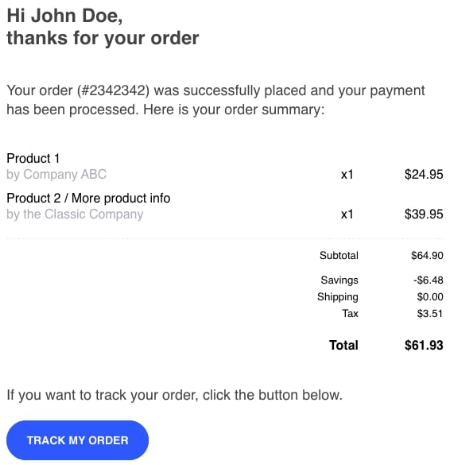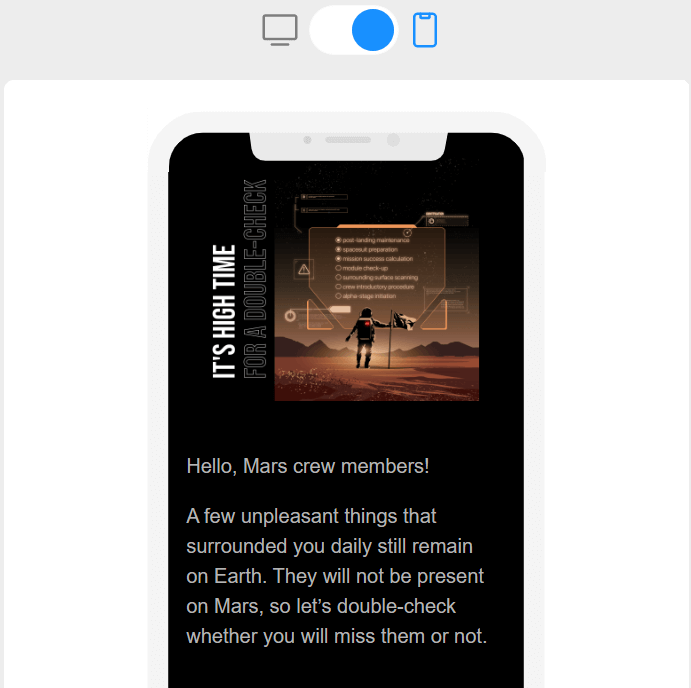Elevate Customer Experience with Our Receipt Email Templates
Create your receipt email template for ecommerce in no time: just customize our ready-made template in the drag-n-drop editor. Our receipt email template is perfect for improving ecommerce customer experience. Use this free template and learn more tips in the article below.
When it comes to ecommerce, receipt emails are an essential part of the customer experience. Not only do they confirm the purchase and payment, but they also provide important details about the transaction and set expectations for delivery. In this guide, we’ll provide you with tips and best practices for creating effective receipt email templates.
Why Receipt Emails Are Important For Ecommerce
Receipt emails are more than just a confirmation of purchase. They are a critical touchpoint in the customer journey that can impact brand loyalty and customer retention. When done right, receipt emails can:
- Set clear expectations for delivery and follow-up
- Reinforce the value of the purchase
- Encourage customers to leave reviews or refer friends
- Improve customer retention and build trustworthy relationships with customers
Essential Elements of a Good Receipt Email Template
If you want to design a good receipt email template, there are several essential elements to include:
- Order confirmation: start with confirming the customer’s order and providing a summary of the items purchased, including prices and quantities.
- Payment confirmation: include a receipt of payment and any related details to your receipt email template, such as the payment method and transaction ID.
- Delivery details: provide an estimated delivery date or tracking information, so customers know when to expect their order.
- Customer service information: include contact details for customer service or support, so customers can easily get in touch if they have questions or concerns. Usually, companies include their contact details in the footer.
- Personalization: Use the customer’s name and any other relevant information to personalize the email.
How to Design a Great Receipt Email Template
Now that you know what to include in your receipt email template, it’s time to think about design. First of all, you can use our ready-made email template to be sure that your design looks stunning. Also, here are some more tips for creating a great receipt email template:
1. Keep it simple
Focus on the essential elements and avoid cluttering the email with unnecessary information or design elements. A receipt email template should be informative above all: it’s not about providing an emotional experience, it’s about important info that should be delivered to the recipient and be clear to them.
2. Use clear, concise language
Write in a friendly, approachable tone and use clear, jargon-free language. You can use a more formal tone in your receipt emails than you usually do in promotional campaigns.
3. Use branding elements
Incorporate your brand’s colors, fonts, and logo to reinforce brand recognition and create a cohesive experience. Adding your brand elements to your receipt email template can also help quickly understand the purpose of the email and build trustworthy relationships with the clients.
4. Optimize for mobile
Many customers will view their receipt email on a mobile device, so make sure your template is mobile-friendly and easy to read on a small screen. Mind that if you design your email template using the Blocks email editor, you can be sure that your email receipt displays correctly across different devices!
Common Mistakes to Avoid in Receipt Email Templates
Here are some common mistakes to avoid in your receipt email templates:
- Failing to personalize: use the customer’s name and any other relevant information to create a more personalized experience and show customers that you care about them and that the information in the email receipt is valid.
- Overwhelming the customer: avoid including too much information or too many calls to action in the email, which can be overwhelming and confusing. The information you should include in your receipt email template is rather limited, so keep it simple. If you want to promote a product, tell about your event in an email, or share the news, send another follow-up email campaign.
- Neglecting design: a poorly designed or unprofessional-looking email can damage your brand’s reputation and undermine customer trust. Use email templates by Blocks to make sure that your email design looks stunning!
By following these tips and best practices, you can create effective receipt email templates that provide a great customer experience and help your business succeed. Use the Blocks email editor to create email templates in minutes.

